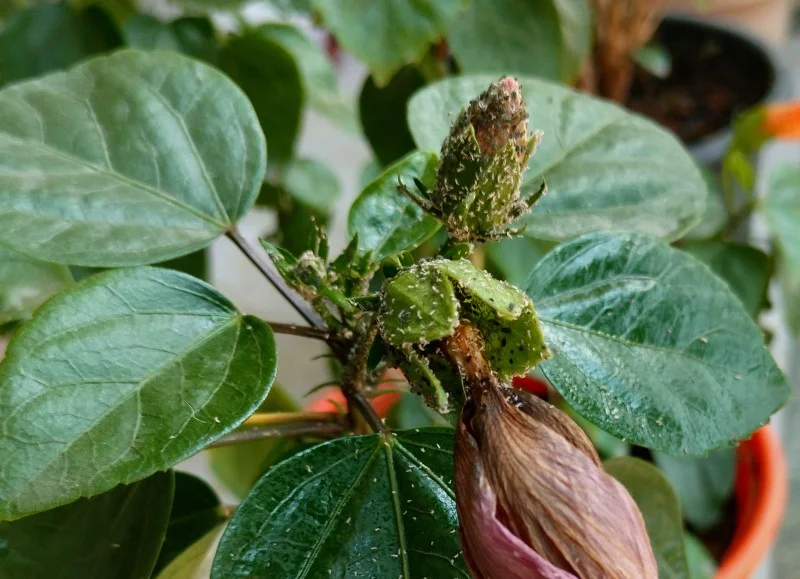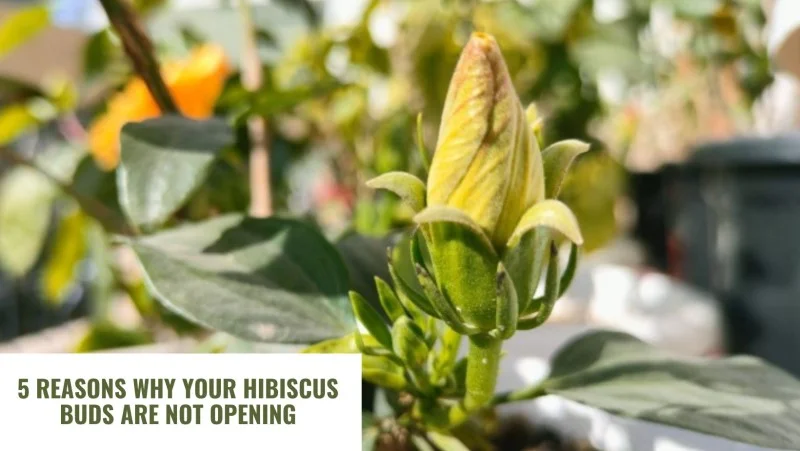
Updated On Feb 14, 2023
The sight of a flowering hibiscus in nature is truly breathtaking and captivating. Their vivid colors and magnificent blossoms are commonly associated with the arrival of spring and the hope of new beginnings.
Yet for some, the anticipation of watching their hibiscus buds come to life can quickly turn into disappointment when these buds refuse to open.
This blog post aims to shed light on the various factors that could be preventing your hibiscus buds from opening, ranging from environmental conditions to disease. So, regardless of whether you are a seasoned horticulturist or a novice, the tips and advice in this article will give you valuable insights and guide you in reviving your hibiscus to reach its full potential.
5 Reasons Why Hibiscus Plant Produces Buds But Does Not Bloom
Inadequate Sunlight
When planting your Hibiscus, make sure to choose a sunny location and avoid shady and windy spots as they can prevent the buds from blooming.
Inadequate sunlight can impact the plant’s ability to produce food through photosynthesis, which can ultimately affect its overall vigor and make it more susceptible to stress.
Remember, in order to achieve optimal growth, it is important to find the right balance between sunlight and heat. This is because sunlight and temperature are interdependent; when the temperature is high, exposure to the sun should be low, and when the temperature is low, exposure to the direct sun should be high.
When both temperature and exposure to direct sunlight decrease, the plant enters into dormancy or dies. In case both exposure to the sun, as well as temperature increases – watering frequency then needs to be altered to keep up with the adverse conditions.
Improper Watering
Another reason why hibiscus buds do not open up is due to over or under-watering. This plant is very sensitive when it comes to watering and requires a delicate approach. Too much watering can result in slow growth and eventually cause bud drop, while underwatering will cause drought stress.
To keep your hibiscus healthy and blooming, it is important to maintain an even level of moisture in the soil. Only water the plant when the top layer of soil has completely dried out, which can be inspected by doing a “two-finger test.”
Moreover, a proper watering schedule should be practiced depending on the nature of the soil and the environment in which the plant is grown.
Standing water is the primary cause of most bacterial and fungal leaf diseases. Root rot is another such phenomenon that occurs due to excess moisture and insufficient oxygen. Pathogens such as pythiaceous fungi can then easily enter through these dead roots and infect the entire plant. This results in wilting, stunted growth, reduction in flowering rate, and frequent bud drops.
For a detailed guide, read this article on how often you need to water your Hibiscus plant.
Nutrient Deficiencies
When a hibiscus plant lacks nutrients, it can cause the buds to remain closed. This is because the plant does not have the necessary energy and minerals to support the development and growth of its flowers. If the deficiency is severe, the buds may not develop at all or may wilt and fall off from the plant.
To help prevent this issue, it is important to regularly monitor the health of your hibiscus plant and provide it with adequate nutrients and water. This can include fertilizing, adjusting soil pH, and monitoring any signs of stress, such as yellowing or stunted growth.
Additionally, it’s important to avoid over-fertilizing: Excessive amounts of any micro or macro nutrients can also create a toxic environment for your plant’s roots, which can prevent the development of new buds. Furthermore, an excess of a particular nutrient can create a deficiency of another, something that is quite common in Hibiscus plants (excessive potassium creates a deficiency of magnesium). So, it is essential to provide an appropriate mix of nutrients to your plants, depending on their stage of growth.
For potted plants, I recommend fertilizers that are high in potassium and moderate in nitrogen, while having a very low phosphorus content. In the case of garden Hibiscus, it is crucial to assess soil conditions and adjust nutrient doses accordingly.
Excessive Heat or Cold
As per research, the rate of leaf unfolding in Hibiscus rosa-sinensis reaches its peak of 0.229 leaves per day at 32°C. On the other hand, the slowest rate of leaf unfolding was observed at 11°C, below which the plant typically goes into dormancy or dies.
The temperature requirements for bud development are similar to those of leaf unfolding. If the Hibiscus plant is exposed to excessively cold or hot temperatures for an extended period, buds may either not form or take a long time to open. Additionally, changes in day length and light intensity can also adversely affect hibiscus plants (Read in detail here: Effect of photoperiod and daily light integral on flowering).
In short, Hibiscus plants prefer warm temperatures, humidity, and sunlight. If the conditions are not favorable, the buds may not open. Additionally, extreme temperature fluctuations, drafts, and dry air can also cause the buds to not open.
Diseases and Pests
The failure of flower buds to bloom is in many cases a consequence of disease or pest infestation. Some of the most common pests that can cause this problem are as follows:
- Spider mites: These tiny, spider-like pests feed on the sap of the plant, causing yellowing of the leaves, stunted growth, and bud drop. In case of severe infestation, the mites can prevent buds from opening.
- Aphids: Aphids are small insects that feed on sap and can cause the yellowing of young unopened buds. They can also cause buds to remain closed.
- Scale insects: These small bugs with a protective shieldlike scale also feed on plant juices causing yellowing and growth disturbances. They can also delay the buds from opening up.
- Fungal diseases: Fungal diseases such as botrytis cinerea and powdery mildew can attack hibiscus plants and cause leaf spots, wilting, and bud drops. As a natural instinct of the plant, it sources all its energy to fight this external attack rather than flowering.
How To Encourage Hibiscus Buds To Open?
Encouraging hibiscus buds to bloom requires patience and attention to detail. You may or may not be aware that hibiscus plants are native to tropical regions, so creating a favorable environment for the plant is crucial for it to thrive.
The first step is to provide the plant with a suitable atmosphere that supports its growth. Ensure that the soil is consistently moist, slightly acidic, and well-drained, with proper airflow and exposure to at least 4-6 hours of direct sunlight.
It is essential to note that a fully matured hibiscus bud takes longer to open up in winter, typically around 15-20 days, and around 4-5 days in the summer. However, the most vital thing is maintaining the plant’s health by protecting it from pests to encourage blooming.

I strongly advise moving indoor hibiscus plants outside as soon as the region’s last frost has occurred to encourage blooming.
Regular pruning, removing dead or damaged branches, and plucking out spent flowers can also help promote bushier growth and encourage more flowering.
In short, to ensure your hibiscus buds open up to their full potential, follow a consistent watering schedule, eliminate aphids and mealybugs, fertilize regularly, and ensure the plant is getting direct sunlight.
With attention to detail and proper care, hibiscus plants can thrive and produce stunning, vibrant blooms in no time!
Don’t get confused between hibiscus buds and seed pods. While they may have a similar appearance, they serve different functions. The bud will bloom into a beautiful flower within a few days, whereas a seed pod will take around a month to mature. Click on this article to read all about Hibiscus seed pods.




